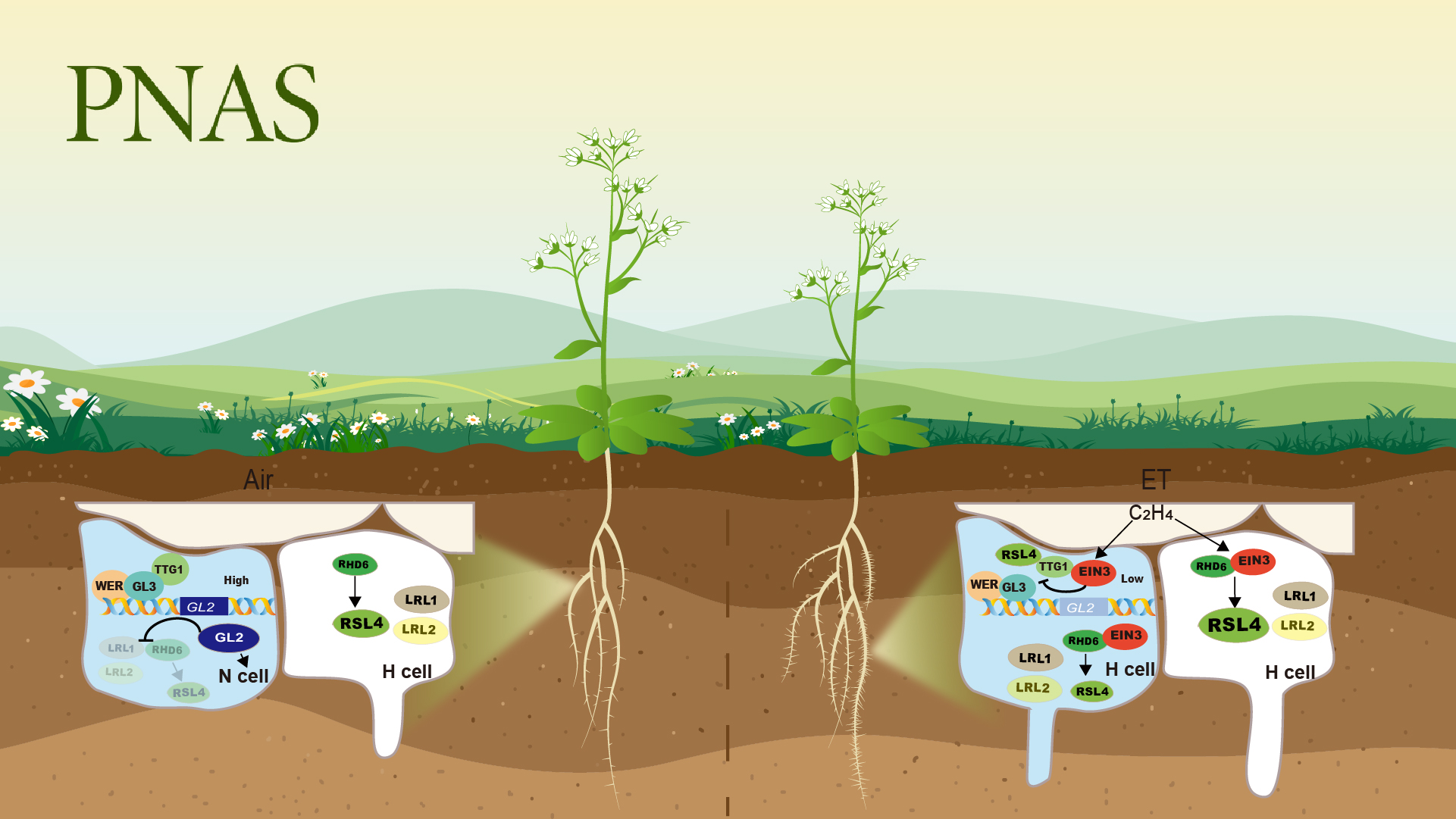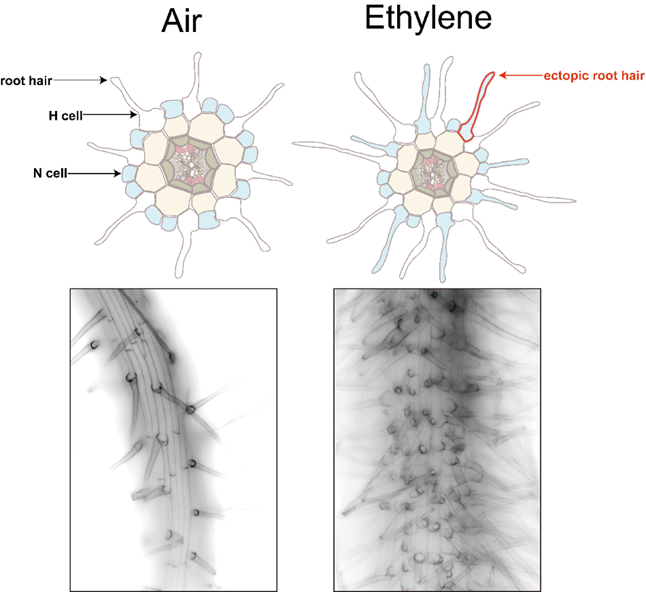Root hairs are unicellular extensions of root epidermal cells that play a vital role in nutrient acquisition and root anchorage. The developmental process of root hairs is jointly regulated by a variety of endogenous and exogenous factors.
Arabidopsis root epidermis differentiates into two cell types according to their positions relative to the underlying cortical cells. The root epidermal cells lying over the clefts between two cortical cells (H-position) develop into root hair cells. In contrast, those lying above one single cortical cell (N-position) acquire a non-hair cell fate (Fig1). Notably, some stress conditions such as nutrient deficiency can induce the N cell to develop root hair, named ectopic root hair. The phytohormone ethylene (ET) has a unique effect of inducing ectopic root hair from N-position epidermal cells. However, the molecular mechanisms underlying ET-induced ectopic root hair development remain enigmatic.

Professor Hongwei Guo from the Southern University of Science and Technology (SUSTech) has studied the molecular mechanisms underlying the regulation of plant root hairs by ethylene for ten years. In 2011, his research group analyzed the molecular mechanism of the interaction between ethylene and jasmonic acid during root hair development (Zhu et al., PNAS, 2011). In 2017, the research group further revealed the specific molecular mechanism of how ethylene regulates root hair elongation (Feng et al., PNAS, 2017).
His team has recently elucidated the molecular mechanism of ET-induced Arabidopsis ectopic root hair formation. This work was published in Proceedings of the National Academy of Sciences of the United States of America (PNAS), entitled “EIN3 and RSL4 interfere with a MYB-bHLH-WD40 complex to mediate ethylene-induced ectopic root hair formation in Arabidopsis”. In this study, the researchers found that ET promotes ectopic root hair formation through downregulation of GL2 expression in an EIN3/EIL1-dependent manner.
The study of ET-induced ectopic root hair formation will help to deeply understand how plants adapt to environmental changes by changing their internal developmental programs. Meanwhile, the study provides an important theoretical basis for cultivating crops that efficiently utilize soil nutrients in the future.
The researchers conducted studies on the molecular mechanism by which EIN3/EIL1 inhibits GL2 transcription. Surprisingly, the dual-luciferase assay results showed that EIN3 has an activating effect on the GL2 promoter in semi-vivo, suggesting a more complex regulatory mechanism for EIN3 to repress GL2 transcription.
Given that GL2 transcription is mainly activated by the WER-GL3-TTG1 transcription ternary complex in vivo, the researchers examined the impact of the EIN3 on the function of this transcription complex. The results showed that the EIN3 specifically inhibited the transcriptional activation of WER-GL3-TTG1 on the GL2 promoter. Furthermore, the researchers verified that the EIN3 physically interacts with TTG1 and interferes with the interaction between TTG1 and GL3, resulting in reduced activation of GL2 by the WER-GL3-TTG1 complex.
Interestingly, they also found that the master regulator of root hair elongation, RSL4, which is directly activated by EIN3, also participates in ET-induced ectopic root hair development. RSL4 negatively regulates the expression of GL2, likely through a mechanism similar to that of EIN3.

Figure 1. The upper cartoon images show the root hair development pattern of Arabidopsis root epidermis under air control (left) and ethylene treatment (right). The lower figures represent the phenotype of root hair of Arabidopsis thaliana (Col-0) under the indicated treatment conditions.
This study elaborated the molecular mechanism of ET-induced ectopic root hair formation in Arabidopsis. Together with the previous research progress, Prof. Guo’s group systematically described the molecular mechanisms of ethylene’s regulation on Arabidopsis root hair development from initiation to elongation.
Qiu Yuping, a joint Ph.D. student at SUSTech and the Harbin Institute of Technology (HIT), is the first author of the paper. Dr. Yichuan Wang, Senior Engineer at SUSTech, and Prof. Hongwei Guo, are the co-corresponding authors. Undergraduate Tao Ran, visiting scholar Feng Ying, research assistants Xiao Zhina and Zhang Dan, Ph.D. student Peng Yang, and engineer Dr. Xing Wen also participated in this research.
The research was supported by the National Natural Science Foundation of China (NSFC), the Key Laboratory of Molecular Design of Plant Cell Factories in Guangdong Province, and the Shenzhen Science and Technology Innovation Committee.
Paper link: https://www.pnas.org/content/118/51/e2110004118
To read all stories about SUSTech science, subscribe to the monthly SUSTech Newsletter.
Proofread ByAdrian Cremin, Yingying XIA
Photo By